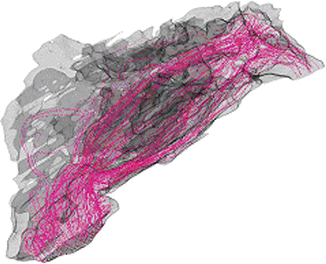Fig. 19.1
Pressure loss over mass flux; Reynolds numbers indicating turbulent conditions
19.2.3 Virtual Reality-Based Visualization of Flow Simulation Results
Visualization is a fundamental ingredient for gaining insights into the simulation results.
In particular, visualization is indispensable to the understanding of complex, dynamic processes observed in computational fluid dynamics, whose scientific and technical analysis requires a multidimensional representation of flow in space and time. In comparison to 2-D or perspective representations, virtual reality-based visualization, i.e., stereoscopic and user-centered projection techniques, allow a much more intuitive comprehension of spatiotemporal correlations. In contrast to animation techniques, virtual reality is inherently interactive and thus allows an interactive exploration of simulation data.
In the context of the project, we are employing different visualization techniques tailored to the needs of the potential users. For the validation of the numerical simulation, we implemented standard visualization techniques like cut planes, isosurfaces, streamlines, and stream ribbons, all primarily based on the visualization toolkit. For the physicians, tailored visualization techniques are still to be determined and to be studied. The added dimensions in the visualization lead to the necessity of a user interface that enables the user to concentrate on the exploration and evaluation of the simulation data via dedicated navigation techniques, speech recognition, and advanced interaction methods for applying the visualization methods. The feedback of users shows that the multimodal user interface supports the visual validation process of the numerical simulation in such a way that the simulation results can be explored in an intuitive manner.
19.3 Application
19.3.1 Nasal Cavity 3D-Imaging-Based Modeling: An Assessment Tool for the Anti-obstructive Potency of Antiallergic Compounds
It was the objective of this study to visualize the anti-obstructive effect of intranasal steroid sprays (INS) in a patient with allergic rhinitis by simulating the nasal airflow with computational fluid dynamics. The patient underwent magnetic resonance imaging (MRI). After nasal allergen challenge, all measurements were repeated 30 min later. During the following 2 weeks, the test subject applied the INS. Then again MRI was performed before and 30 min after allergen challenge.
Figure 19.2 compares the nasal flow before and after allergen challenge at baseline. Before allergen exposure, a pattern of widespread flow distribution over the entire nasal cavity can be noticed (left). After exposure to the allergen, flow to the more cranial parts of the nasal cavity becomes sparse (right).
Figure 19.3 shows the flow patterns in the nasal cavity calculated from the MRI-based model after 14 days of (prophylactic) treatment with an intranasal steroid. Again, the distribution of airflow at baseline is widespread over the entire nasal cavity. Velocity of airflow is somewhat reduced after allergen challenge, however, by far not as pronounced as before treatment. We therefore conclude that this demonstrates the anti-obstructive effect of the intranasal steroid.
Similar improvements could be demonstrated for the treatment with an anti-obstructive antihistamine comparing the flow pattern at baseline (Fig. 19.4) with the flow pattern after 5 weeks of treatment (Fig. 19.5).




Fig. 19.2
Nasal airflow at baseline before (left) and after (right) allergen challenge

Fig. 19.3
Nasal airflow after 2 weeks of treatment with an intranasal steroid before (left) and after (right) allergen challenge

Fig. 19.4




Nasal airflow at baseline after allergen challenge
Stay updated, free articles. Join our Telegram channel

Full access? Get Clinical Tree


